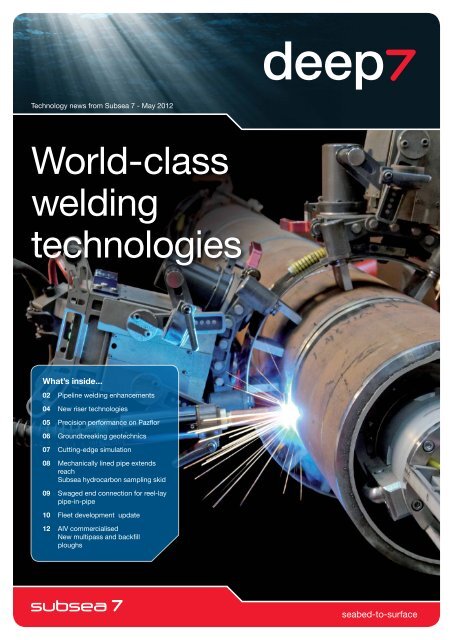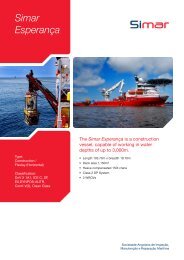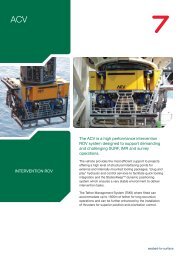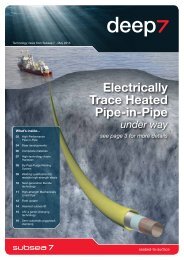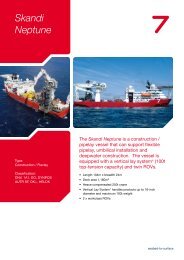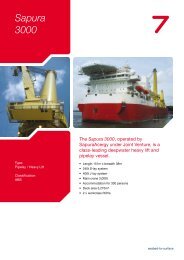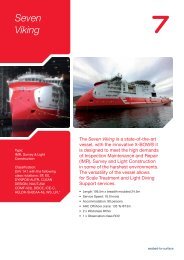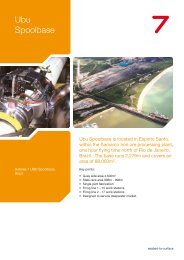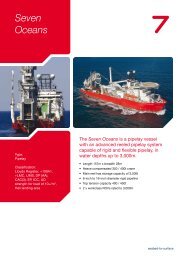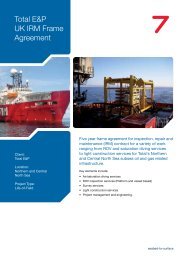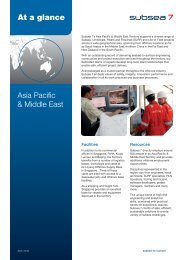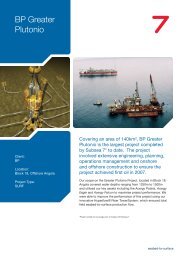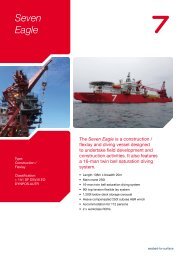World-class welding technologies - Subsea 7
World-class welding technologies - Subsea 7
World-class welding technologies - Subsea 7
Create successful ePaper yourself
Turn your PDF publications into a flip-book with our unique Google optimized e-Paper software.
Technology news from <strong>Subsea</strong> 7 - May 2012<br />
<strong>World</strong>-<strong>class</strong><br />
<strong>welding</strong><br />
<strong>technologies</strong><br />
What’s inside...<br />
02 Pipeline <strong>welding</strong> enhancements<br />
04 New riser <strong>technologies</strong><br />
05 Precision performance on Pazflor<br />
06 Groundbreaking geotechnics<br />
07 Cutting-edge simulation<br />
08 Mechanically lined pipe extends<br />
reach<br />
<strong>Subsea</strong> hydrocarbon sampling skid<br />
09 Swaged end connection for reel-lay<br />
pipe-in-pipe<br />
10 Fleet development update<br />
12 AIV commercialised<br />
New multipass and backfill<br />
ploughs<br />
deep<br />
seabed-to-surface
02<br />
In-depth technology news<br />
More than ever before, <strong>Subsea</strong> 7 continues to<br />
commit to the development and commercialisation<br />
of new technology, vessels and equipment that<br />
deliver technical and cost-effective solutions to our<br />
clients in their increasingly challenging environments<br />
and operational scenarios.<br />
Many of our most effective <strong>technologies</strong> are<br />
developed in active collaboration with key suppliers<br />
from our supply chain. Our development partners<br />
play an important role in the emergence of effective<br />
new ideas and solutions for our clients, and they<br />
cover a unique range of <strong>technologies</strong> which reflect<br />
our global expertise and capability.<br />
We are proud to<br />
have received<br />
recent industry<br />
recognition of one<br />
of our pipeline<br />
<strong>technologies</strong><br />
from the Pipeline<br />
Industries Guild.<br />
One of the industry’s<br />
foremost bodies,<br />
the Guild presented<br />
<strong>Subsea</strong> 7 with the<br />
prestigious “<strong>Subsea</strong><br />
Pipeline Technology Award” at their annual dinner<br />
in London in March for our development work on<br />
the installation of mechanically lined pipe using the<br />
reel–lay method, (see page 8 for details of current<br />
development work).<br />
In this latest issue of deep7, you can read<br />
about our latest applied technology advances<br />
in disciplines ranging from pipeline <strong>welding</strong> to<br />
geotechnics, and from advanced vessel design<br />
to the installation of ground-breaking subsea<br />
infrastructure.<br />
To find out more about any of the<br />
<strong>technologies</strong> featured in this issue contact<br />
John Mair, Technology Development Director<br />
at john.mair@subsea7.com or email<br />
communications@subsea7.com<br />
DEEP7 May 2012<br />
Welding<br />
enhancements<br />
in the pipeline<br />
<strong>Subsea</strong> 7 is developing and implementing leading-edge pipeline<br />
<strong>welding</strong> <strong>technologies</strong> to satisfy evolving market demand - both<br />
in terms of technical specifications and volume - and to meet<br />
increasingly stringent pipeline fabrication codes and operator<br />
specifications.<br />
Underpinning this technology development are three important<br />
strategic investments by the company:<br />
• entering into a technical partnership with CRC-Evans Pipeline<br />
International (CRC), one of the world’s leading designers and<br />
manufacturers of automatic <strong>welding</strong> systems for pipeline<br />
construction<br />
• committing to an extensive <strong>welding</strong> R&D programme to meet future<br />
industry demands<br />
• the opening in 2013 of a new Global Welding Development Centre<br />
in Glasgow, managed by <strong>Subsea</strong> 7’s Pipeline Production Group<br />
(PPG).<br />
Pipeline performance is currently being challenged on a number of<br />
fronts – not only by high demands on the performance of pipeline<br />
<strong>welding</strong> processes and the assurance of the integrity of girth welds,<br />
but also by the increasing usage of higher strength steels, clad/lined<br />
and solid corrosion-resistant alloy (CRA) pipe.<br />
<strong>Subsea</strong> 7 is implementing a <strong>welding</strong> methodology which meets the<br />
following criteria:<br />
• Adoption of a common approach to <strong>welding</strong> processes and<br />
equipment across all fabrication sites<br />
• Use of <strong>welding</strong> processes which allow the heat input to be<br />
controlled precisely to optimise weld mechanical and corrosion<br />
properties whilst ensuring weld soundness<br />
• Use of mechanised <strong>welding</strong> whenever practical in order to minimise<br />
welder intervention.<br />
<strong>Subsea</strong> 7’s reeled pipeline production facility at Vigra in Norway,<br />
accommodates the latest mechanised <strong>welding</strong> technology, and
demonstrates how careful assessment of project requirements<br />
and production factors can deliver cost-effective <strong>welding</strong><br />
solutions. The new technology is about to be deployed in<br />
Brazil, and will thereafter be rolled out to <strong>Subsea</strong> 7’s other<br />
fabrication sites worldwide.<br />
In the case of larger-diameter carbon steel pipelines, the use<br />
of the mechanised Pulsed Gas Metal Arc Welding (PGMAW)<br />
process is now established as the <strong>welding</strong> method of choice<br />
for both riser and flowline applications. The process utilises<br />
low-heat input which results in excellent mechanical properties<br />
in the girth welds.<br />
The process can be deployed using either single torch, or in<br />
the case of larger diameter pipe, dual torch <strong>welding</strong> in order<br />
to improve productivity. This system is highly mechanised so<br />
that the role of the <strong>welding</strong> operator is simply to supervise the<br />
process with minimal intervention required.<br />
Since the current <strong>welding</strong> system was introduced to Vigra in<br />
early 2011, about 400km of carbon steel pipeline have been<br />
fabricated, with productivity and quality exceeding targets.<br />
The overall weld repair rate, which is a key quality indicator, is<br />
less than 0.5%.<br />
<strong>Subsea</strong> 7 has further developed the PGMAW process for use<br />
in the fabrication of metallurgically clad pipe.<br />
Welding of clad pipe requires the use of dissimilar <strong>welding</strong> filler<br />
material, i.e. Alloy 625. <strong>Subsea</strong> 7 has carried out extensive<br />
<strong>welding</strong> trials to optimise pulsed <strong>welding</strong> parameters and<br />
shielding gas composition.<br />
The qualified PGMAW solution makes use of the Controlled<br />
Metal Transfer (CMT) process for root <strong>welding</strong>, an advanced<br />
PGMAW technique which allows the weld root to be deposited<br />
very precisely, giving good control of the root bead quality and<br />
profile. These features are essential to maintain the corrosion<br />
03<br />
performance of the clad pipeline. During production, an<br />
internal camera and laser profiling device is utilised to perform<br />
an assessment of the quality of the root bead.<br />
The developed <strong>welding</strong> solution will be implemented in<br />
production this year for a number of pipeline projects, which<br />
will involve over 70km of metallurgically clad and mechanically<br />
lined pipe risers.<br />
For smaller diameter pipes (4-inches and below) a mechanised<br />
<strong>welding</strong> system has been developed by <strong>Subsea</strong> 7 and<br />
implemented at Vigra. A key benefit of this system is to<br />
provide a more precise control of the heat input in order to<br />
maintain the optimum mechanical and corrosion performance.<br />
This solution, initially deployed on a 2-inch duplex stainless<br />
steel service line, was based on the use of the orbital Gas<br />
Tungsten Arc Welding (GTAW) process using the Polysoude<br />
<strong>welding</strong> system. Production <strong>welding</strong> has been in progress<br />
since November 2011 with weld quality and productivity<br />
meeting expectations, and has confirmed that this technology<br />
can be successfully deployed on a global basis.<br />
The 2-inch duplex line was also a Vigra “first” for the use of an<br />
automatic arc monitoring system on the firing line to capture<br />
and record the essential <strong>welding</strong> parameters.<br />
Operations will begin in 2013 at <strong>Subsea</strong> 7’s new Global<br />
Welding Development Centre in Glasgow, which will<br />
incorporate 18 <strong>welding</strong> bays including facilities for J-lay and<br />
S-lay pipeline <strong>welding</strong>, and will act as a central technical<br />
authority for the development and qualification of all <strong>welding</strong><br />
procedures for all <strong>Subsea</strong> 7 pipeline fabrication bases around<br />
the world.<br />
This major initiative by <strong>Subsea</strong> 7 will give clients the assurance<br />
of quality and delivery of pipeline <strong>welding</strong> performance at a<br />
competitive cost.<br />
For further information contact eric.law@subsea7.com<br />
seabed-to-surface
04<br />
New riser <strong>technologies</strong><br />
under construction<br />
Many years of applied research and<br />
construction experience have given<br />
<strong>Subsea</strong> 7 the significant advantage<br />
of being a SURF contractor capable<br />
of providing all types of riser systems<br />
for deepwater and ultra-deepwater<br />
installation, depending on the field<br />
architecture and client needs.<br />
This in-house capability includes<br />
design, procurement, construction,<br />
installation and maintenance.<br />
Riser systems installed on a worldwide<br />
basis by <strong>Subsea</strong> 7 fall into two<br />
categories - those coupled directly<br />
to the host facility, and un-coupled<br />
systems which in most cases are<br />
connected to the host by flexible<br />
jumpers and are increasingly being<br />
applied in recent deepwater and ultradeepwater<br />
field developments.<br />
<strong>Subsea</strong> 7 continues to develop<br />
innovative un-coupled riser concepts<br />
designed for harsh and challenging<br />
environments.<br />
HRTs<br />
Hybrid Riser Towers (HRTs) are<br />
recognised to have significant benefits<br />
for deepwater riser applications in<br />
terms of flow assurance, thermal<br />
performance and robustness of<br />
layout. This latter issue is especially<br />
significant when a large number of<br />
risers are considered. An HRT provides<br />
the required flexibility by avoiding<br />
a crowded layout and allowing a<br />
progressive deployment. The concept<br />
is applicable to deepwater and ultradeepwater,<br />
and to spread-moored and<br />
turret-moored FPSO installations.<br />
The first HRT application installed by<br />
<strong>Subsea</strong> 7 was Girassol in Angola for<br />
Total in 1998. The field, incorporating<br />
three HRTs, has been producing for<br />
over ten years to the specified stringent<br />
flow assurance requirements.<br />
HRTs have now become accepted as a<br />
robust solution for deepwater and ultradeepwater<br />
developments. The latest<br />
<strong>Subsea</strong> 7 HRT technology is currently<br />
being applied to Total’s CLOV projects<br />
offshore Angola where two HRTs will be<br />
installed in 2013.<br />
For further information contact john.mair@subsea7.com<br />
DEEP7 May 2012<br />
BSR<br />
The Buoyancy Supported Riser (BSR)<br />
system is being delivered by<br />
<strong>Subsea</strong> 7 for the Guará and Lula NE<br />
field development in Brazil under<br />
contract to Petrobras for installation in<br />
late 2012/early 2013.<br />
The BSR concept consists of a large<br />
sub-surface buoy which is anchored<br />
to the seabed by eight tethers, two on<br />
each corner of the buoy. The buoy<br />
supports multiple Steel Catenary Risers<br />
(SCRs) which are connected to the<br />
FPSO by non-bonded flexible jumpers.<br />
This BSR system absorbs the dynamics<br />
from the FPSO, resulting in almost no<br />
dynamic stresses on the SCRs, making<br />
them behave like a long free-spanning<br />
pipeline with the major fatigue response<br />
coming from the Vortex Induced<br />
Vibration due to the local currents.<br />
Since there is very little dynamic<br />
response for the SCRs, mechanically<br />
lined pipe is used for the SCR section,<br />
thereby optimising the riser design.<br />
COBRA<br />
<strong>Subsea</strong> 7’s most recent riser concept<br />
is the Catenary Offset Buoyant Riser<br />
Assembly (COBRA), which consists<br />
of a catenary riser section with a long,<br />
slender buoyancy module on top which<br />
is tethered down to the sea bed. Similar<br />
to the multi–riser BSR, the top of the<br />
catenary riser section is connected to<br />
the host by a flexible jumper.<br />
COBRA is a highly compatible riser<br />
arrangement for host platforms with<br />
large motions, like FPSOs or semisubmersibles.<br />
This riser concept has the advantages<br />
of excellent dynamic performance with<br />
little or no fatigue response, and can<br />
therefore be designed for pipeline<strong>class</strong><br />
welds. This therefore allows the<br />
use of mechanically lined pipe where<br />
appropriate, as in the case of the<br />
Buoyancy Supported Riser.<br />
Other riser systems such as Grouped<br />
SLOR and Single Hybrid Risers are also<br />
part of <strong>Subsea</strong> 7’s un-coupled Riser<br />
portfolio.<br />
Hydrid Riser Towers (HRTs)<br />
Buoyancy Supported Riser (BSR)<br />
Buoyancy<br />
SCR<br />
Jumper<br />
Mooring lines<br />
Catenary Offset Buoyant Riser Assembly (COBRA)
Planning and precision<br />
combine on Pazflor<br />
The successful installation by<br />
<strong>Subsea</strong> 7 of three subsea separation<br />
units (SSUs), operated by Total E&P<br />
Angola, proved critical to the early<br />
completion of the landmark Pazflor<br />
project on Block 17, offshore Angola.<br />
The challenging project involved the<br />
world’s first deployment of vertical<br />
SSUs to separate the oil, gas and<br />
water produced from Pazflor’s<br />
Miocene reservoirs.<br />
Installing each SSU (weighing in excess<br />
of 1,000t, including suction anchors)<br />
required an unprecedented level of<br />
precision in water depths around 800m<br />
and a close working relationship with<br />
Total and the SSU manufacturer, FMC,<br />
to ensure the final design included<br />
offshore installation requirements.<br />
Operational requirements necessitated<br />
exceptionally tight installation<br />
tolerances of +/- 0.5° from horizontal<br />
when installing the cluster of four<br />
suction anchor foundations. To achieve<br />
this target, <strong>Subsea</strong> 7 developed the<br />
lifting arrangement, and interfaced with<br />
FMC to accurately operate the levelling<br />
system based on differential suction.<br />
Early analyses showed a risk of<br />
resonance of the subsea hardware<br />
during lowering, potentially leading<br />
to significant weather sensitivity. To<br />
mitigate this issue, <strong>Subsea</strong> 7 developed<br />
a real-time monitoring system receiving<br />
acceleration data from sensors located<br />
on the crane tip and on top of the<br />
hardware as they were lowered.<br />
Extensive dry and shallow water testing<br />
in Norway allowed the team to test<br />
the SSU installation before the units<br />
were finally transported to Angola.<br />
Working in close liaison with FMC,<br />
<strong>Subsea</strong> 7 coordinated transportation<br />
and designed a specific sea fastening<br />
to minimise fatigue of the SSUs. Prior<br />
to deployment on site by <strong>Subsea</strong> 7’s<br />
installation vessel the Acergy Polaris,<br />
the structure’s integrity was re-tested in<br />
Luanda bay.<br />
Connecting each SSU to the subsea<br />
manifold was a complex and delicate<br />
operation in which the ROV operators<br />
had to first remove caps from the<br />
SSU shallow water tests in Norway<br />
manifold followed by the operation of<br />
a jacking system to slide the 400t, sixstorey<br />
high SSU towards the manifold to<br />
mate three connections simultaneously.<br />
The Seven Eagle performed the SSU<br />
umbilical installation and the tie-in of the<br />
first pair of four multi-phase pumps.<br />
The landmark project, in which first<br />
oil was achieved ahead of schedule<br />
including the development and<br />
installation of new technology,<br />
underlines the importance of effective<br />
interfaces between suppliers,<br />
contractors and client.<br />
<strong>Subsea</strong> 7 continues to develop new<br />
deployment systems including fibrerope<br />
and active-heave compensation<br />
that are deemed essential in the<br />
deployment and retrieval of sensitive<br />
rotating machinery and processing<br />
systems in ever-increasing water depths<br />
of the future.<br />
A Pazflor SSU being installed<br />
05<br />
seabed-to-surface
06<br />
Groundbreaking geotechnics<br />
In 2011, <strong>Subsea</strong> 7 commenced<br />
accelerated development in the<br />
field of Geotechnics in two areas of<br />
great significance for our clients’<br />
deepwater operations, how seabed<br />
soils and pipelines interact, and how<br />
an enhanced appreciation of soil<br />
behaviour and failure mechanisms<br />
can optimise foundation design,<br />
particularly for very soft deepwater<br />
clays.<br />
Pipelines<br />
<strong>Subsea</strong> 7 actively participates in the<br />
Safebuck series of JIPs - currently in its<br />
third phase - but we have also internally<br />
funded work investigating the dynamic<br />
embedment (and hence friction and<br />
stability) of pipes laid on soft clays which<br />
are typically found at the deepwater sites<br />
where we work.<br />
Another key challenge being addressed<br />
is an improved understanding of the<br />
behaviour of carbonate sediments which<br />
are widespread in some developing oil<br />
and gas-rich regions such as Australia.<br />
Carbonate-rich soils exhibit different<br />
behaviour to their non-carbonate<br />
counterparts, so <strong>Subsea</strong> 7 undertook<br />
a study to investigate the response of<br />
carbonate soils to cyclic pipe loads<br />
by model testing in a geotechnical<br />
centrifuge.<br />
Model pipe set up for axial friction test<br />
The results of this study are counterintuitive<br />
to those predicted by <strong>class</strong>ical<br />
soil mechanics, and the work represents<br />
a significant step forward in evolving a<br />
new constitutive model to describe the<br />
behaviour of carbonate soils.<br />
For further information contact paul.brunning@subsea7.com<br />
DEEP7 May 2012<br />
Apparent friction derived from cyclic axial friction tests<br />
Foundations<br />
In our subsea construction business,<br />
there is constant pressure to optimise<br />
foundation design to be as efficient as<br />
possible in terms of installation without<br />
compromising functionality.<br />
<strong>Subsea</strong> 7 has produced recent research<br />
at the highly respected Centre for<br />
Offshore Foundation Systems at the<br />
University of Western Australia into an<br />
optimised design methodology that has<br />
led to the possibility of reducing the size<br />
of shallow foundations such as PLET<br />
mudmats by 20%, or alternatively able<br />
to withstand larger jumper loads.<br />
The geotechnical engineer is always<br />
interested in finding the most critical<br />
failure mechanism of a foundation.<br />
<strong>Subsea</strong> 7 has teamed up with the<br />
university to develop a new 3D analysis<br />
tool which could potentially halve the<br />
engineering hours spent designing<br />
foundations under complex loading.<br />
FE analysis for optimised foundation design<br />
Mudmats for PLET applications<br />
Looking to the future…<br />
Emerging challenges in the<br />
geotechnical industry are likely to<br />
include:<br />
• developing and improving<br />
the constitutive model for<br />
carbonate soils and applying<br />
it to foundation and pipeline<br />
design<br />
• how to quantify the degrading<br />
effects of solid hydrate and<br />
hydrate dissociation on soil<br />
properties<br />
• further optimisation of<br />
foundation designs as large<br />
and heavy processing facilities<br />
are moved subsea<br />
• developing design methods<br />
for ultra-deepwater soils where<br />
soil strength is more dominated<br />
by viscous behaviour than<br />
traditional shear strength<br />
• finding novel and effective<br />
ways to protect subsea<br />
infrastructure in the Arctic or<br />
ice-prone regions.
Cutting-edge simulation<br />
<strong>Subsea</strong> 7 has developed one of the<br />
most powerful installation simulation<br />
packages ever built, including<br />
unique finite element analysis<br />
(FEA) capabilities, and successfully<br />
installed the hardware on board<br />
construction vessel the Seven<br />
Seas for effective on-site operative<br />
training.<br />
The programme was developed over a<br />
two-year period for the Block 31 project<br />
offshore Angola. An unusual aspect of<br />
this deepwater project is the mid-water<br />
pull-in of the flexible risers that connect<br />
the vertical risers to the FPSO. These<br />
operations are carried out at an average<br />
depth of 200m, which presented<br />
uncommon problems.<br />
Unlike most pull-ins, the tasks are<br />
performed in a situation where<br />
everything in the scenario is mobile.<br />
The Upper Riser Assembly (URA), while<br />
weighing several hundred tonnes, can<br />
be easily moved and rotated should the<br />
ROV push it. When the flexible risers<br />
are attached to the subsea winch wires<br />
and the load transferred from the vessel<br />
crane to the winches, the URA, which<br />
in itself is dynamic, tends to follow the<br />
riser lay direction for many metres -<br />
which has the potential to compromise<br />
the minimum bending radius (MBR) of<br />
the flexible.<br />
The situation was risk-assessed, and<br />
it was decided that the risks could be<br />
mitigated by building the nine different<br />
scenarios (there are nine flexible<br />
risers) in a simulator. This would allow<br />
procedures to be checked, and also<br />
facilitate pilot training. The simulation<br />
predictions were shown to correlate well<br />
with measurements taken before and<br />
during the actual offshore operation.<br />
The development of the simulator<br />
though 2010 and 2011 pushed the pilottraining<br />
software and hardware well<br />
beyond their existing capacity, due to<br />
the large number of flexible and moving<br />
objects in each scenario.<br />
Most simulation training takes place at<br />
<strong>Subsea</strong> 7’s site in Aberdeen, but for this<br />
project it proved more effective to train<br />
the ROV pilots, superintendents, and<br />
Block 31 installation simulator in use on board the Seven Seas<br />
bridge supervisors on board the Seven<br />
Seas, in an environment with which they<br />
are already familiar.<br />
The simulations feature:<br />
• Variable sea conditions which can<br />
produce realistic motions of the<br />
Seven Seas (<strong>Subsea</strong> 7’s construction<br />
vessel on Block 31)<br />
• Sea currents that can be varied<br />
in both strength and direction at<br />
different depths to replicate the<br />
currents throughout the entire<br />
2,100m water column<br />
• Two Hercules ROV systems, each<br />
with fully working manipulators and<br />
three selectable onboard cameras<br />
• Real-time FEA package calculating<br />
loads on, and MBR of, the flexibles<br />
• Two subsea winches complete with<br />
working line-out meters and load<br />
cells.<br />
The simulation FEA calculates the minimum<br />
bending radius of the flexible during ROV<br />
operations<br />
07<br />
The on-board simulator uses the<br />
existing Hercules 23 control console,<br />
with an additional six powerful PCs. A<br />
switch disconnects the topside control<br />
system from the ROV and changes<br />
operations from normal ROV control to<br />
simulation mode (this is only done when<br />
the vehicle is on deck!).<br />
For further information contact mike.bramley@subsea 7.com<br />
seabed-to-surface
08<br />
Mechanically lined pipe extends reach<br />
<strong>Subsea</strong> 7’s ground-breaking development work into the<br />
installation of mechanically lined pipe has recently been<br />
undergoing further qualification following the world’s<br />
first contract award to use BuBi ® mechanically lined pipe<br />
installed by the reel-lay method for the Guará and Lula NE<br />
pre-salt project in Brazil.<br />
Working in collaboration with BuBi ® manufacturer BUTTING,<br />
<strong>Subsea</strong> 7 has already qualified BuBi ® mechanically lined<br />
pipe for reel-lay installation for flowlines and low-fatigue riser<br />
applications globally as a cost-effective alternative to solid<br />
corrosion-resistant alloys or metallurgically clad pipe. We are<br />
now broadening the product’s applications into areas of higher<br />
pressure and fatigue applications.<br />
Current testing has demonstrated higher fatigue performance<br />
to DNV <strong>class</strong> C/2 at the time of print to extend the applicability<br />
of the technology to even greater water depths and more<br />
challenging design criteria.<br />
The rigorous fatigue testing programme included:<br />
• Manufacture of three test strings (12 girth welds) comprising<br />
carbon steel grade X65 for the outer pipe and alloy 625 for<br />
the liner, made up of BuBi ® pipe sections welded together<br />
using the mechanised PGTAW process (see page 3) with<br />
alloy 625 filler metal<br />
• A conservative cyclic bending test or reeling simulation,<br />
using a radius of curvature of 7.5m<br />
• Resonance fatigue testing of the string post-reeling<br />
simulation. The endurance of the pipe and its welds was<br />
thus confirmed to achieve the minimum target level of<br />
fatigue <strong>class</strong> C/2.<br />
DEEP7 May 2012<br />
The full programme was<br />
performed in accordance with<br />
DNV Qualification (DNV-<br />
RP-A203) and was previously<br />
awarded the certificate for<br />
‘fitness for service’.<br />
An extensive NDE validation programme was conducted<br />
between <strong>Subsea</strong> 7 and BUTTING to qualify the inspection<br />
technology (DNV) and demonstrate the capacity to detect any<br />
minute defects in the pipe end overlay welds and seal weld at<br />
the transition between liner and overlay.<br />
The combination of the high-quality manufacturing process and<br />
inspection technology is fundamental to ensure the in-service<br />
reliability of the technology.<br />
<strong>Subsea</strong> Hydrocarbon Sampling Skid (SHSS)<br />
Following the successful<br />
development of its<br />
<strong>Subsea</strong> Hydrocarbon<br />
Sampling Skid (SHSS),<br />
<strong>Subsea</strong> 7 is now able<br />
to offer clients ROVdeployed<br />
sampling from<br />
live production wells<br />
with zero emissions<br />
to the environment<br />
while maintaining full<br />
isothermic and isobaric<br />
conditions.<br />
Hydrocarbon samples are required in order to determine<br />
fluid chemistry to enable calibration of the subsea flowmeter<br />
and potential fiscal allocations. The <strong>Subsea</strong> 7 SHSS takes<br />
a true sample with no need to alter production flow or<br />
temperature.<br />
It also takes samples from individual wells before they<br />
are mixed together at manifold or FPSO, and enables<br />
production samples or gases from individual wells to be<br />
analysed independently.<br />
The Welding Institute (TWI)<br />
Fatigue Test Rig<br />
S-N curves showing the number of<br />
fatigue cycles reached to date on three<br />
test strings (RF1, RF2, RF3). No failure<br />
of the pipe or liner seal welds has been<br />
recorded at the DNV <strong>class</strong> C.<br />
For further information contact gregory.toguyeni@subsea7.com<br />
The skid comprises the following key elements:<br />
• A number of sampling cylinders allowing several samples<br />
to be taken from multiple locations/wells<br />
• A controlled rate of fill and heating system ensures the<br />
sample is taken in an isobaric and isothermal manner.<br />
• The host ROV provides the skid with power and telemetry.<br />
• Topsides control is via a robust laptop PC.<br />
• A heating system maintains the sample cylinders and<br />
pipework at a sufficiently elevated temperature in order<br />
to mitigate the formation of hydrates during the sampling<br />
process and dissolved gases coming out of solution.<br />
• A fail-safe connection tool ensures the safe shutdown<br />
of the sample interface at the well should the ROV<br />
experience a vessel run-off or dead vehicle situation.<br />
The SHSS is the latest in a long <strong>Subsea</strong> 7 tradition of<br />
developing pioneering high-quality, cost-effective ROV<br />
tooling, including a standard range of manipulator-deployed<br />
tools, component change-out tools, bespoke intervention<br />
tools and skids.<br />
For further information contact mick.fowkes@subsea7.com
Swaged end connection for reel-lay<br />
high performance pipe-in-pipe<br />
In collaboration with its development partner ITP InTerPipe,<br />
<strong>Subsea</strong> 7 currently offers the market its DNV-qualified<br />
Enhanced Thermal Performance Pipe-in-Pipe system for<br />
installation by the reel-lay method. This superior technical<br />
solution, which benefits from the combination of Izoflex<br />
insulation material in conjunction with a reduced pressure in<br />
the PIP annulus section, has recently been further enhanced<br />
by the development and qualification of the Swaged Field<br />
Joint.<br />
The Swaged End Connection has already been widely used by<br />
<strong>Subsea</strong> 7 on J-lay and S-lay PIP projects, but this new concept<br />
relates to reel-lay applications.<br />
The Swaged End Connection is fabricated by swaging the<br />
pipe ends of the outer sleeve pipe, followed by <strong>welding</strong> to the<br />
flowline at each end of the fabricated stalk, typically 750m long<br />
for reel-lay applications. The sealed annulus within the stalk<br />
can then have the pressure drawn down within the annulus offline<br />
in advance of reeling onto the reel-lay vessel.<br />
As each stalk is subsequently reeled onto the vessel, the PIP<br />
swaged end stalks are fabricated together by firstly girth<strong>welding</strong><br />
of the flowlines and the use of welded half shells for<br />
the outer sleeve pipe.<br />
The Swaged End Connection’s primary function is to provide<br />
the following:<br />
• A leak-tight seal for draw-down of pressure within the<br />
annulus<br />
• A robust mechanical barrier to act as a water stop in all<br />
envisaged water depths in the event that the outer pipe is<br />
breached, thus preventing the entire pipeline annulus from<br />
flooding<br />
• A means of mechanical connection between the flowline and<br />
outer sleeve pipe that can be reeled.<br />
Testing and qualification<br />
has focused primarily on<br />
the following areas in order<br />
to attain DNV “Fitness for<br />
Service” Qualification in<br />
compliance with DNV-RP<br />
A-203:<br />
• FEA modelling<br />
• Simulated reeling and straightening trials<br />
• Welding and inspection<br />
• Post-reeling FEA analysis using strain data collated from the<br />
simulated reeling and straightening trials<br />
• Material testing<br />
• Annulus pressure test<br />
Enhanced Thermal Performance PIP incorporating<br />
Izoflex insulation material with reduced pressure and no<br />
centralisers in the annulus section<br />
Sleeve Pipe<br />
Flowline<br />
Pipe-in-Pipe cross section<br />
FE analysis<br />
Svalin C reeled PIP<br />
<strong>Subsea</strong> 7’s expertise in high performance Pipe-in-<br />
Pipe (PIP) installations covers full-scope design,<br />
procurement, construction and installation, and extends<br />
to over 40 successful PIP projects including bundle<br />
technology, S-lay, J-lay and reel-lay.<br />
Our latest project comprises a 5-inch/8-inch gas lift<br />
Pipe-in-Pipe, to be designed, constructed and installed<br />
for Statoil between the Svalin C Template and the<br />
Grane platform in the central North Sea. The contract<br />
also covers the installation of the Svalin C template and<br />
manifold, a highly wet-insulated production flowline,<br />
and an umbilical.<br />
In addition to our market-leading versatility in the<br />
installation of high performance Pipe-in-Pipe, <strong>Subsea</strong> 7<br />
can also install electrically trace-heated flowline (ETHF)<br />
PIP solutions by reel-lay or in towed bundles.<br />
ETHF technology has been successfully<br />
commercialised by <strong>Subsea</strong> 7 in partnership with<br />
manufacturer ITP InTerPipe to combine highperformance<br />
thermal insulation with low-power resistive<br />
heating elements. Now technologically qualified by<br />
DNV for reel-lay installation, ETHF offers a highly<br />
efficient means of maintaining product temperature in<br />
the most challenging subsea environments.<br />
09<br />
For further information contact paul.booth@subsea7.com<br />
seabed-to-surface
10<br />
Fleet development update<br />
<strong>Subsea</strong> 7’s industry-leading commitment to fleet<br />
development is directly driven by our identification and<br />
anticipation of our clients’ needs for their increasingly<br />
challenging subsea field developments.<br />
Whether for highly complex deepwater installations, extended<br />
Life-of-Field operations or enhanced <strong>welding</strong> performance,<br />
<strong>Subsea</strong> 7 is committed to working in close collaboration with<br />
our vessel-build and equipment partners to incorporate client<br />
requirements in the design of new vessels and upgrading of<br />
existing vessels.<br />
The five new vessels profiled here all reflect, in their different<br />
ways, elements of our commitment to deploy a fleet of<br />
New-build<br />
Seven Borealis<br />
With its pipelay and heavy-lift<br />
capabilities, <strong>Subsea</strong> 7’s Seven<br />
Borealis is possibly the most<br />
versatile offshore construction<br />
vessel. Its 5,000t crane, with<br />
the top of the mast reaching<br />
150m above the main deck,<br />
is the world’s largest offshore<br />
mast crane. Recent lift<br />
tests in Singapore proved its<br />
capability of lifting 5,000t.<br />
The Seven Borealis joins the<br />
fleet in the second half of<br />
2012.<br />
New-build flexible pipelay support vessel (PLSV)<br />
<strong>Subsea</strong> 7 has been awarded a contract to provide a 550t<br />
top-tension PLSV for Petrobras for delivery in 2014. This<br />
top-tension capability gives the vessel <strong>Subsea</strong> 7’s highestperforming<br />
flexible pipelay capability in the fleet, and among<br />
DEEP7 May 2012<br />
unrivalled capacity and versatility, and one which offers our<br />
clients access to over 40 vessels with the highest standards of<br />
flexibility and project reliability.<br />
Enhanced vessel specifications like crane and moonpool<br />
capacities are designed to accommodate the hardware which<br />
we plan to deploy for the future in support of our clients.<br />
This is particularly evident in our latest flagship enabling vessel,<br />
the Seven Borealis, which not only features world-leading<br />
lifting capabilities, but will also incorporate <strong>Subsea</strong> 7’s latest<br />
mechanised <strong>welding</strong> <strong>technologies</strong> on its J-lay and S-lay firing<br />
lines (see pages 2 and 3).<br />
the highest for any PLSV in the world. This high specification<br />
reflects the existing and anticipated demand of Brazilian ultradeepwater<br />
operations.<br />
The vessel is scheduled to have a 550t Tiltable Lay System<br />
(TLS) installed, with two 275t retractable tensioners to handle<br />
flexible products between 100mm and 630mm outer diameter.<br />
The tower can tilt to 10o when operational to recover rigid pipe<br />
from the seabed but it can also tilt to 50o from the vertical to<br />
allow the TLS to clear power cables across the entrance to<br />
Vitoria harbour.<br />
The two underdeck carousels will also be of the open-top<br />
“basket” design. The new PLSV also incorporates a number of<br />
further design innovations to meet the specific requirements of<br />
the Brazilian market. The vessel will be fitted with underwater<br />
demountable thrusters which can be removed and replaced<br />
while the vessel is afloat.
Seven Viking<br />
Due for launch in late 2012, the Seven Viking is designed as a “next<br />
generation” Inspection, Maintenance and Repair (IMR) vessel, with<br />
enhanced seakeeping qualities and environmental performance. The<br />
Seven Viking will enter a long-term frame agreement with Statoil for<br />
operations in the North, Norwegian and Barents Seas.<br />
The Seven Viking incorporates a number of design features to minimise<br />
mobilisation times and optimise transit speeds, most notably an<br />
innovative hull shape which offers increased foreship volume and<br />
slender waterlines. As well as offering improved seakeeping capabilities<br />
(fully operational in 5m significant wave height), this design also provides<br />
a larger working deck area, with a raised freeboard and working stations<br />
enclosed in a heated indoor hangar to enable IMR operations in rough<br />
seas and extreme temperatures.<br />
Other innovations which facilitate harsh weather operations include a<br />
skidding module handling system to store and move up to eight different<br />
modules into the moonpool, eliminating the risk of hanging loads, and<br />
de-ice facilities and a strengthened hull for operations in Arctic areas.<br />
Seven Inagha<br />
<strong>Subsea</strong> 7 has an impressive track record in<br />
developing innovative equipment, and this is<br />
confirmed by a new vessel joining the fleet in 2012.<br />
The Seven Inagha started her life in 2011 as a<br />
high-capacity Gulf of Mexico liftboat. During her<br />
construction, she was purchased by <strong>Subsea</strong> 7 and<br />
began her conversion into an extremely capable<br />
platform for hook-up operations in West Africa.<br />
The Seven Inagha is effectively a vessel with<br />
legs, and, unlike most conventional jack-ups,<br />
can mobilise to a work site under her own power.<br />
She has an impressive lifting capacity with two<br />
295t cranes fitted, and will commence operations<br />
offshore Nigeria. With enhanced facilities able to<br />
accommodate up to 150 people on board, she will<br />
provide utility services and support to hook-up<br />
teams on offshore installations.<br />
The three eye-catching tubular 97.5m legs have<br />
pairs of racks which allow the 36 planetary motors<br />
to jack the hull at a speed of 2.4m per minute,<br />
elevating the hull to a maximum height of 88m<br />
above the seabed in water depths of up to 76m<br />
when operating in hook-up mode.<br />
Seven Havila<br />
The state-of-the-art diving support vessel, the<br />
Seven Havila, which is owned by <strong>Subsea</strong> 7 and<br />
Havila Shipping and is widely considered to<br />
be the most advanced<br />
vessel of its type in the<br />
world, has achieved<br />
a world first by<br />
simultaneously deploying<br />
eight saturation divers<br />
from a single vessel.<br />
The advanced diving<br />
system on the vessel includes a ten-chamber,<br />
24-men fully computerised saturation suite,<br />
with a double bell handling system capable of<br />
working down to 400m and up to 6m significant<br />
wave height.<br />
11<br />
seabed-to-surface
Autonomous Inspection Vehicle (AIV) commercialised<br />
Following extensive inwater<br />
testing in 2011, the<br />
final software systems<br />
and design adjustments<br />
on <strong>Subsea</strong> 7’s pioneering<br />
Autonomous Inspection<br />
Vehicle (AIV) have been<br />
implemented, and<br />
this game-changing<br />
technology is now<br />
being successfully<br />
commercialised.<br />
The Mark 1 inspection<strong>class</strong><br />
vehicle is being<br />
deployed into customer<br />
qualification programmes AIV deployment system<br />
during 2012, and the<br />
development paths of the next generations of fully capable,<br />
work-<strong>class</strong> sized intervention vehicles are already being laid.<br />
A differentiating element of the AIV is its ability to recognise<br />
and respond to its surroundings - it will correct its trajectory in<br />
real time, based on the information it gathers from its onboard<br />
sensors. This level of intelligence and decision-making has had<br />
to be de-risked and made as robust as possible, so a powerful<br />
virtual reality simulator was used to ensure that every option was<br />
identified and assessed.<br />
New multipass and backfill ploughs<br />
<strong>Subsea</strong> 7 has recently invested in two high-performance<br />
subsea ploughs that will significantly enhance our delivery<br />
capability on the burial of trenched pipelines.<br />
Our new Variable Multi-Pass Plough (VMP), as the name<br />
suggests, has the capability to perform a number of passes<br />
through the seabed to achieve the specified depth. However,<br />
where the VMP has a significant advantage over other ploughs<br />
is in its ability to alter its cut depth without recovery, thereby<br />
reducing operational timings.<br />
Another design innovation is the VMP’s fore-cutter, in front of<br />
the main cutting tool, which enables this plough to function in<br />
stiffer soil conditions.<br />
The VMP already has a proven track record, completing an<br />
extensive variety of pre- and post-cut trenches in varying soil<br />
www.subsea7.com<br />
DEEP7 May 2012<br />
Variable Multi-Pass Plough<br />
© <strong>Subsea</strong> 7, 2012. Information correct at time of going to press.<br />
In collaboration with one of the world’s leading underwater<br />
simulator suppliers, a detailed specification was developed<br />
to allow “hardware-in-the-loop” testing. The final system,<br />
probably one of the most sophisticated in existence, allows<br />
the real AIV computational hardware to control a dynamic<br />
simulation model of the AIV within a virtual world that<br />
contains a full 3D representation of an offshore oilfield. This<br />
package provides full emulation of the sensor packages<br />
and simulation of the vehicle dynamics operating around<br />
representative subsea infrastructure.<br />
Although this simulation uses a bank of some of the fastest<br />
industrial computers available, it allows AIV missions to<br />
be run hundreds of times to ensure that the AIV decisionmaking<br />
behaviour is robust.<br />
The visual inspection capability of the AIV Mark 1 will lead<br />
to more cost-efficient and effective integrity management<br />
throughout the lifetime of a subsea field development.<br />
As customer qualification of the visual inspection vehicle<br />
proceeds, <strong>Subsea</strong> 7 is simultaneously engaging with<br />
subsea developers, industry bodies and field development<br />
strategists to explore how autonomous technology can<br />
further enhance the challenging subsea operations of the<br />
future.<br />
For further information contact hugh.ferguson@subsea7.com<br />
conditions around the world for large-diameter pipelines,<br />
trucklines and flowlines.<br />
To complement the VMP, <strong>Subsea</strong> 7 has also invested in a<br />
Backfill Plough (BFP), which redeposits the soil from the VMPcut<br />
trench back into the void once the product is laid. The<br />
ability to provide a quality backfill with the BFP significantly<br />
enhances both the thermal insulation and resistance to<br />
upheaval buckling.<br />
Backfill Plough 2<br />
The ploughs have already been deployed by another recent<br />
addition to the <strong>Subsea</strong> 7 fleet - the highly versatile Skandi<br />
Skansen which, with a 250t heave-compensated crane, a<br />
300t A-Frame and a bollard pull of 350t, is ideally suited to<br />
support many field installation operations, including ploughing<br />
campaigns.<br />
For further information contact farquhar.mitchell@subsea7.com


